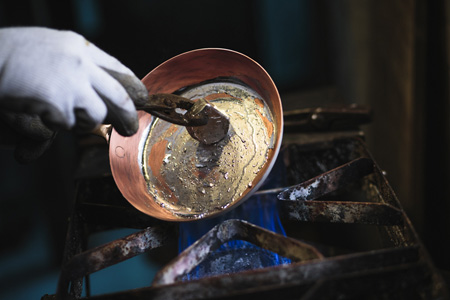East Coast Tinning: Copperware’s Resilience in Restoration
 Melting an ingot of pure tin onto the cooking surface during the tinning process.
Melting an ingot of pure tin onto the cooking surface during the tinning process. Photograph courtesy of East Coast Tinning.
After stumbling upon a worn out copper stockpot in 2003, Jim Hamann brought it home, determined to learn how to restore and use it.
As a mechanical engineer fascinated with cooking, he began retinning the piece, watching the transformation unfold. Soon, he was hooked, and by 2006, he opened East Coast Tinning in East Greenwich, Rhode Island. Today, people from across the United States ship their aged and worn copper pots and pans to Hamann’s shop for restoration.
By 2008, he started making his own kitchenware with a second new business called Duparquet Copper Cookware, re-registering the trademark from the 19th century design and style of Duparquet Huot & Moneuse, Co. In 1936, the company couldn’t survive the Great Depression.
Having started his retinning business out of his home in the early days, today Hamann operates in a former textile mill building which is more than a century old. He has trained a few employees to aid in the restoration process, passing on the craft.
“Retinning is a periodic relining of the cooking surface,” Hamann says in describing a technical definition of one of the main aspects of his restoration efforts. “It allows you to use a piece of cookware which might be 100 to 150-years-old. Having that cookware on your stove and that history in the pan, you wonder what was cooked in it before.”
Hamann removes the old tin lining of a particular piece and joins in a new one with flux before buffing and polishing all surfaces, including the rich copper exterior sections.
 A completely refinished splayed sauce pan. The interior is re-lined with new tin, and the exterior buffed to a high shine.
A completely refinished splayed sauce pan. The interior is re-lined with new tin, and the exterior buffed to a high shine.Photograph courtesy of East Coast Tinning.
The old character underneath stays, he says.
“The goal is to make as thick of a layer as possible so that it lasts a long time,” he describes of the initial focus in retinning. “Too much tin and it would be goopy.”
The pan heats to more than 500° Fahrenheit at maximum heat.
“The tinning itself is an art,” Hamann says. “It’s a learned skill. In summer, it’s 100° Fahrenheit outside, and you’re over a stove heating to about 475°.”
In recent years, Hamann has been able to spot trends based on the work he receives and where it originates. He noticed that many French people were leaning toward contemporary cookware versus antiquated pieces from the kitchens of their grandmothers. But, his state-side clients had a newfound appreciation.
“A lot of people in the U.S. are buying pans from France on eBay and having them sent here,” he adds.
Clients talking and sharing stories at dinner parties is one way word-of-mouth translates to online inquiries about fixing up antique and vintage cookware.
“I see pieces from the 1880s to the 1980s,” he says.
Copper cookware is a universal choice for chefs of all generations. Hamann said they especially appreciate how the same temperature is distributed throughout a piece of cookware with copper, in the need to accurately and artfully prepare food for restaurant-goers.
“Copper is a great conductor of heat,” Hamann adds. “It spreads the heat evenly throughout a pot or pan. That ring of fire from the burner is not just passing through the pan. The whole pan is the conductor.”
Once restored, customers love passing on these copper kitchen heirlooms to future generations.
“There are really personal stories with them,” Hamann says about the kitchenware he restores. “The pans are very meaningful to these people.”
Resources:
Also in this Issue:
- Special Effects Sculpting Brings Copper to the Center Stage
- Copper Kingdom: Old World Inspired Copper Gaming Pieces
- Invigorating Life Size Bronzes with Classic Realism
- East Coast Tinning: Copperware’s Resilience in Restoration
- Bronze and Copper Hippo Ballerina Installed at NYC’s Lincoln Center
